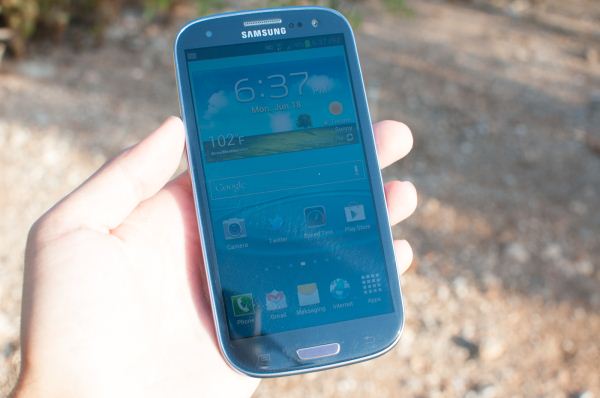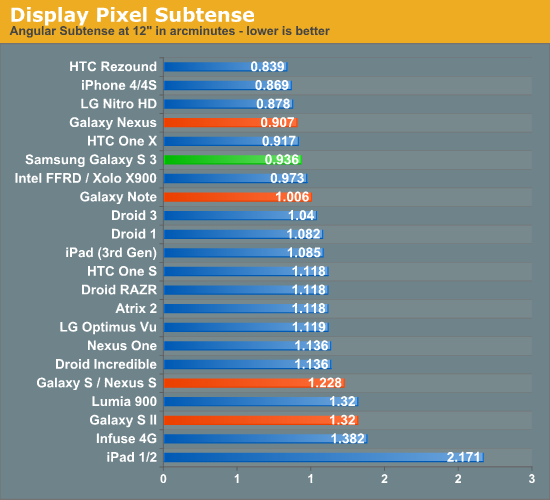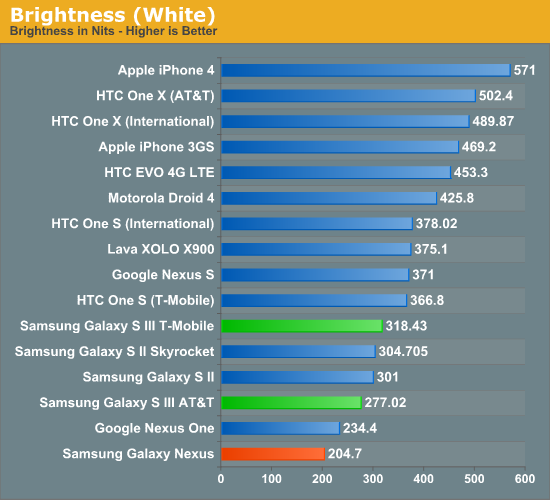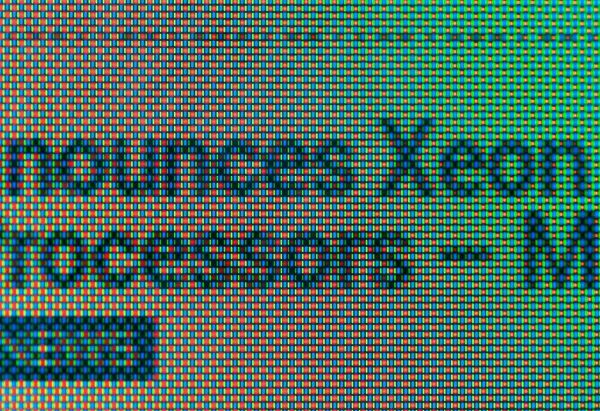Samsung Galaxy S III Review - AT&T and T-Mobile USA Variants
by Brian Klug on June 20, 2012 12:01 AM ESTOne of the standout features on the SGS3 is the 4.8" HD SAMOLED display, which has an effective resolution of 1280x720. Like other Samsung devices, the name tells you almost everything you need to know: HD connotes 720p, S for Super means the stack is optically bonded with fewer air gaps (and thus fewer fresnel 4% back reflections), and the lack of Plus means it’s an RGBG PenTIle subpixel matrix.
First off, it’s clear to me that the SGS3 display is a substantial improvement on the Galaxy Nexus display, which was 4.65" diagonal and also 720p HD SAMOLED. The problems that I talked about in the Galaxy Nexus display are basically completely absent in the SGS3. There’s no longer any mura (luminance variance which looks like noise) or a weird purple cast in the greys, two things that are still present on the Galaxy Nexus. I suspect that moving to a larger display with the same resolution (and thus larger subpixels) might have helped mitigate some of the mura, and in addition this appears to be a completely new revision of the process with none of those problems.

Outdoor viewing angles are pretty darn good
I think it’s also worth discussing PenTile once more - specifically in the context of whether or not you can see the pixels. At this point, I don’t think we need to go over what it is in much detail, but that it uses two sets of two subpixel units to achieve higher effective resolution than an RGB stripe. There are two variants - RG, BW which I’ve seen in a few Motorola LCD displays (that are Samsung), and RG, BG, which is the more common variant that is in all the AMOLED panels without the “plus” suffix.
The implementations that I complained loudest about were really the Nexus One and Nexus S / Galaxy S, where AMOLED was still somewhat in its infancy, and RG, BG was both a way to increase subpixel lifetime before fading took place (according to Samsung), and achieve a higher logical resolution with fewer subpixels than an RGB stripe would require. For that reason, you can’t really just evaluate a display with some boolean is garbage / not garbage based on the presence of PenTile alone. In theory, if the logical two-pixel cell is itself smaller than human visual acuity, then you shouldn’t be able to see it, and seeing the pixels is what drove me crazy about those two phones.
I present the following graph, which has the angular subtense in arcminutes along the stripe (when a device is held portrait, this is the x direction) of one logical pixel. That is to say, two subpixels if we’re talking about an RGBG PenTIle display, or three for an RGB display. For reference, human visual acuity is most often cited as being around 1 arcminute for the human vision system corrected to 20/20, which isn’t perfect vision (20/15 or slightly better is). Anything below that should be indistinguishable at a distance of 12 inches (standard viewing distance).

This is what I’m talking about when I say that in implementations such as the SGS3, even though PenTile is present, the logical pixel is still smaller than visual acuity, and the subpixels are half that. There’s still a case to be made for whether you can see fringing on black text on a white background to some extent, but personally I cannot see it.
So how is the display in other terms, such as brightness, color rendering, and viewing angles? For this I turned to the combination of my display colorimeter (still an i1D2), ColorHCFR, and Francois’s excellent Voodoo Screen Test Patterns.
When it comes to brightness, I found that oddly enough the T-Mobile and AT&T devices differed by a measurable and repeatable margin. Possibly these are from completely different batches, possibly there is some optimization done for the display brightness dynamic range to conserve battery - I’m not sure. Either way, it’s there, but the SGS3 is thankfully brighter than the Galaxy Nexus, though it still seems to be clamped to a fairly conservative number.

I measured blacks a few times and tried to see if I could get a reading on whether the SGS3 also has a slight DC bias (not fully off), but still couldn’t get anything. If it’s there, I haven’t noticed it yet.
In the Color HCFR testing, we can see that gamma looks very weird and nonlinear across the greys, going from around 2.4 down to 1.2, I have no idea what’s going on here. Color temp is thankfully a bit more controlled, at just under 7000K, and relatively flat.

I measured both devices after seeing that there was variance, and uploaded the color.chc files for both the AT&T and T-Mobile model for people with HCFR installed to check out. I’ve also made two galleries for the respective panels. I’ve heard really good things about the International SGS3 from Francois (supercurio), but haven’t measured it yet. I guess these initial numbers make me suspect that like SGS2 the USA variants have differences in the display rendering. I will say that over a range of brightnesses the SGS3 seems to have much less of the color shift compared to other AMOLEDs I’ve seen in the past.























107 Comments
View All Comments
HexiumVII - Wednesday, June 20, 2012 - link
Darn no quad core love for the US?Impulses - Wednesday, June 20, 2012 - link
No big loss, the S4 is roughly equivalent despite being a dual, since it's an all new design instead of a core bump. The GPU is actually the bigger loss, if you're into graphically intensive games.B3an - Wednesday, June 20, 2012 - link
Exactly.The international quad-core version (which i have and love!) is based on ARM Cortex A9. While the US dual-core version uses the Krait SoC which is a lot closer to ARM's new Cortex A15 design (but it's not an A15, it's a custom design from Qualcomm thats similar in performance). So overall for CPU performance the international and US versions are pretty similar.
The international version definitely has a better GPU though - the higher clocked Mali-400 is the fastest GPU in any phone at the moment. Where as the US version has the slower Adreno 225.
On the other hand... the US version has 2GB RAM, where as the international has 1GB.
I guess Samsung felt bad about the slower GPU and tried to make up for it by giving you all 2GB instead.
Personally i prefer the international version because of the extra GPU performance as i do more gaming, and with a screen this big @ 720p gaming is great.
robinthakur - Friday, June 22, 2012 - link
So...quick question. I have an international version which I picked up in HK as well. What games actually make good use of the improved graphics? I've already got Angry Birds Space. I'm not that impressed with the device so far. The thin plastic back feels incredibly cheap for a device costing around £400 and the Android OS seems poorly optimised compared to the iPhone 4S I used to use, with much worse touch controls. The camera which initially sold me (along with the nice water drops animations on the Home screen!) with its rapid shots, also disappoints with pretty mediocre pictures compared to the 4S. Front facing camera is nicer though. The motion controls are utterly pointless as is face unlocking. Have you ever got the wave hand across the screen to take a screenshot to work? I've got it switched on but...nothing! There were plenty of options compared to iOS for to geek out over for 48 hours but now having to actually use the device it seems lacking, i dunno, just unpolished. Considering it just came out, why is text all fuzzy for example? Isn't this a retina display? I assumed that coming out more than 2 years after the iPhone 4, every phone has them these days, but apparently not. I'm considering selling it before the price drops and going back into the Apple Matrix as life seems easier with iOS all told.JamesL88 - Saturday, June 23, 2012 - link
"What games actually make good use of the improved graphics?"Well for starters newest Gameloft games such as the NOVA 3 tend to be very graphically demanding. Also True Android gamers love to buy emulators from black markets (or after markets if you prefer), such as Nintendo 64 emulator.
You're obviously iFan so I'm not going into discussion with strength and weaknesses of each OS, but I believe the GS3 uses the same Sony sensor used in iPhone 4s' camera. I seriously doubt that you even own GS3.
koyanishi - Tuesday, September 4, 2012 - link
I believe he does own a Galaxy S III.that's because he didn't figure out how to take the screen shot by swiping his hand across the screen.
The thing is, to do this your hand has to touch the screen. Your hand is in the form of a karate chop and you use the knife edge (sort to speak) to touch the screen and swipe across it.
I don't think he is that stupid for missing this because I after trying different ways of doing it never figured it out either but only learned of how to do it by reading tips on use of this phone in an android forum.
However on his other points of how the plastic feels cheap and lack of optimization (whatever that means) of the os in GS III I disagree.
bigboxes - Wednesday, June 20, 2012 - link
Am I wrong? The device doesn't look like it can stand up to much of anything. Better make sure you cover it from top to bottom with some kind of case.ATWindsor - Wednesday, June 20, 2012 - link
You probably are, plastics can be very solid and lightweight. The old Galaxy S2 is as far as one can tell much more solid than for instance the iphone.Impulses - Wednesday, June 20, 2012 - link
Samsung's designs may feel cheap at times but that doesn't necessarily translate to better impact survivability... Plastic weighs less and probably absorbs more force during impact... I've never owned a Samsung phone (I'm on my third EVO and my dumb phones were all Nokias & Sony) but I've seen plenty of them fly from my friend's hands. :p The glossy plastic they use probably does scuff easier than most materials tho. Then again, unlike reviewers who go thru phones like underwear, I think the majority of people end up it using cases anyway. I do it to protect my device's resale value as much a anything else.Belard - Wednesday, June 20, 2012 - link
What resale value?